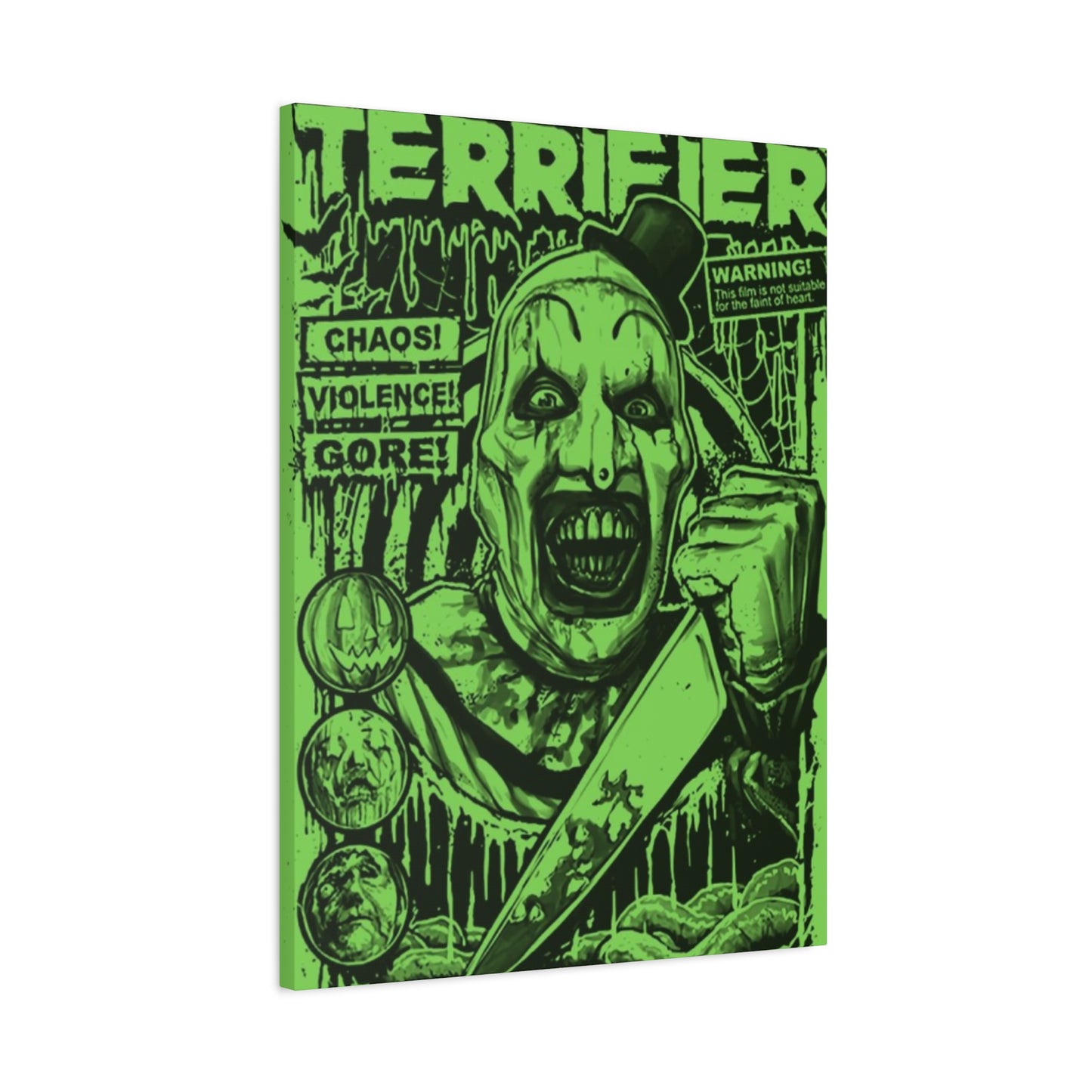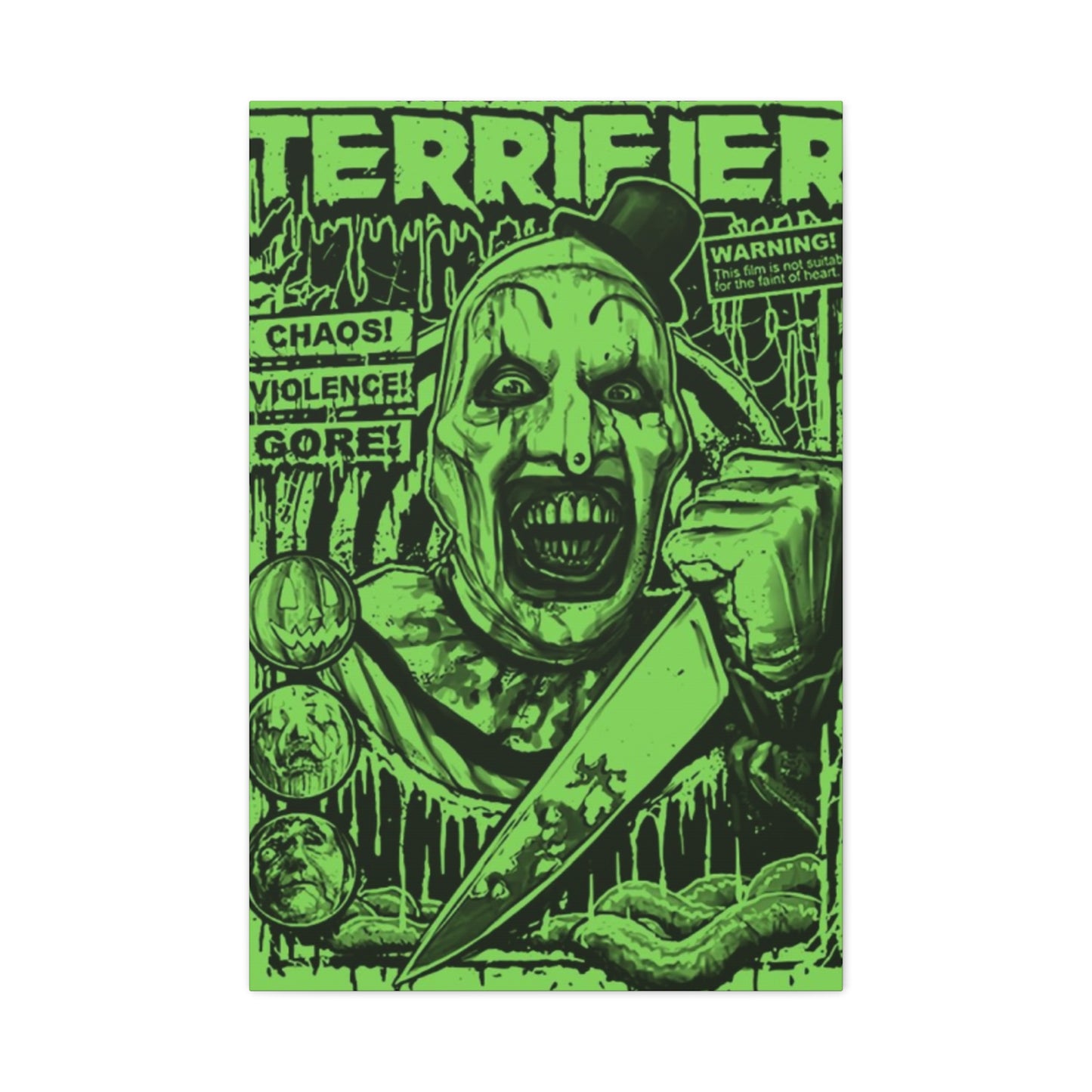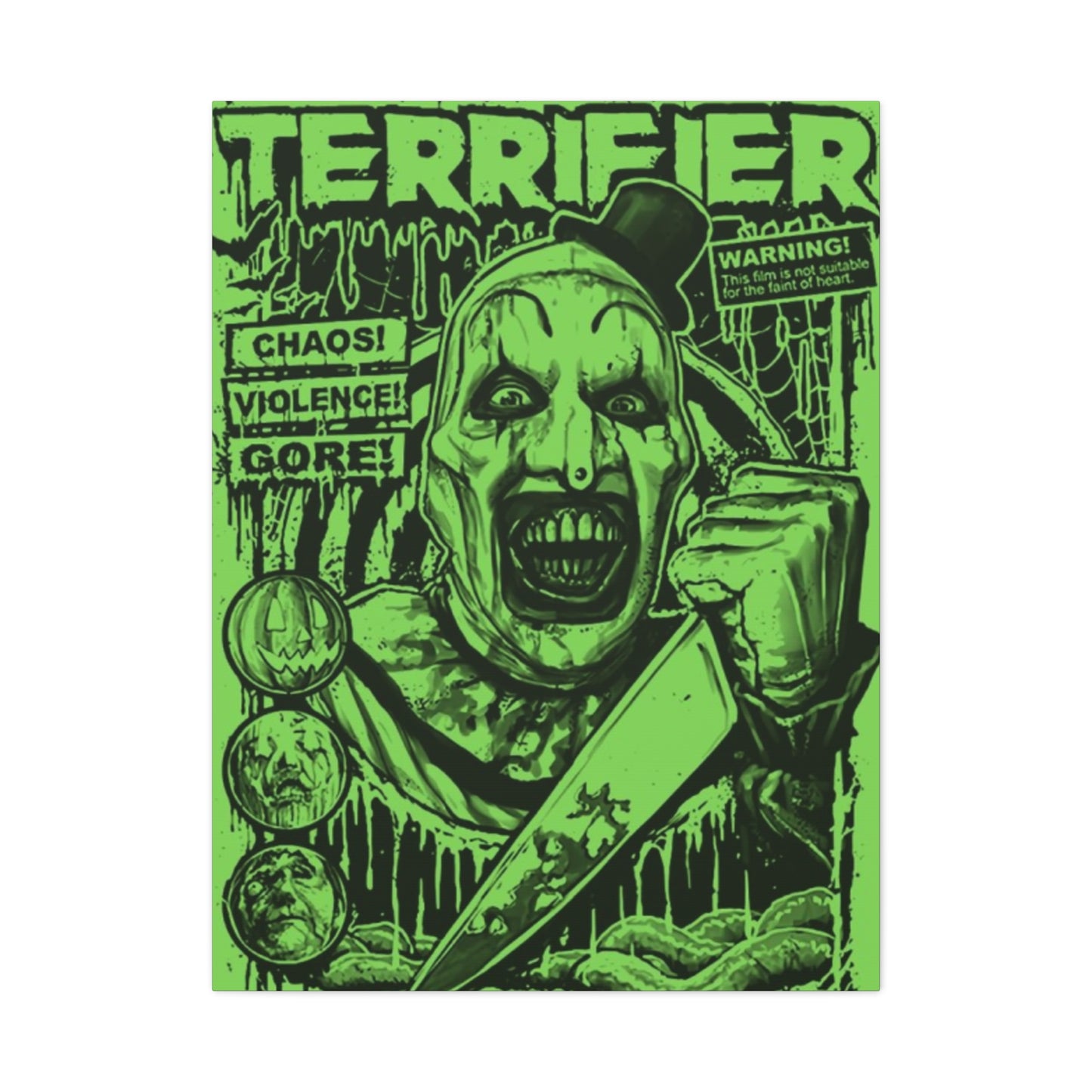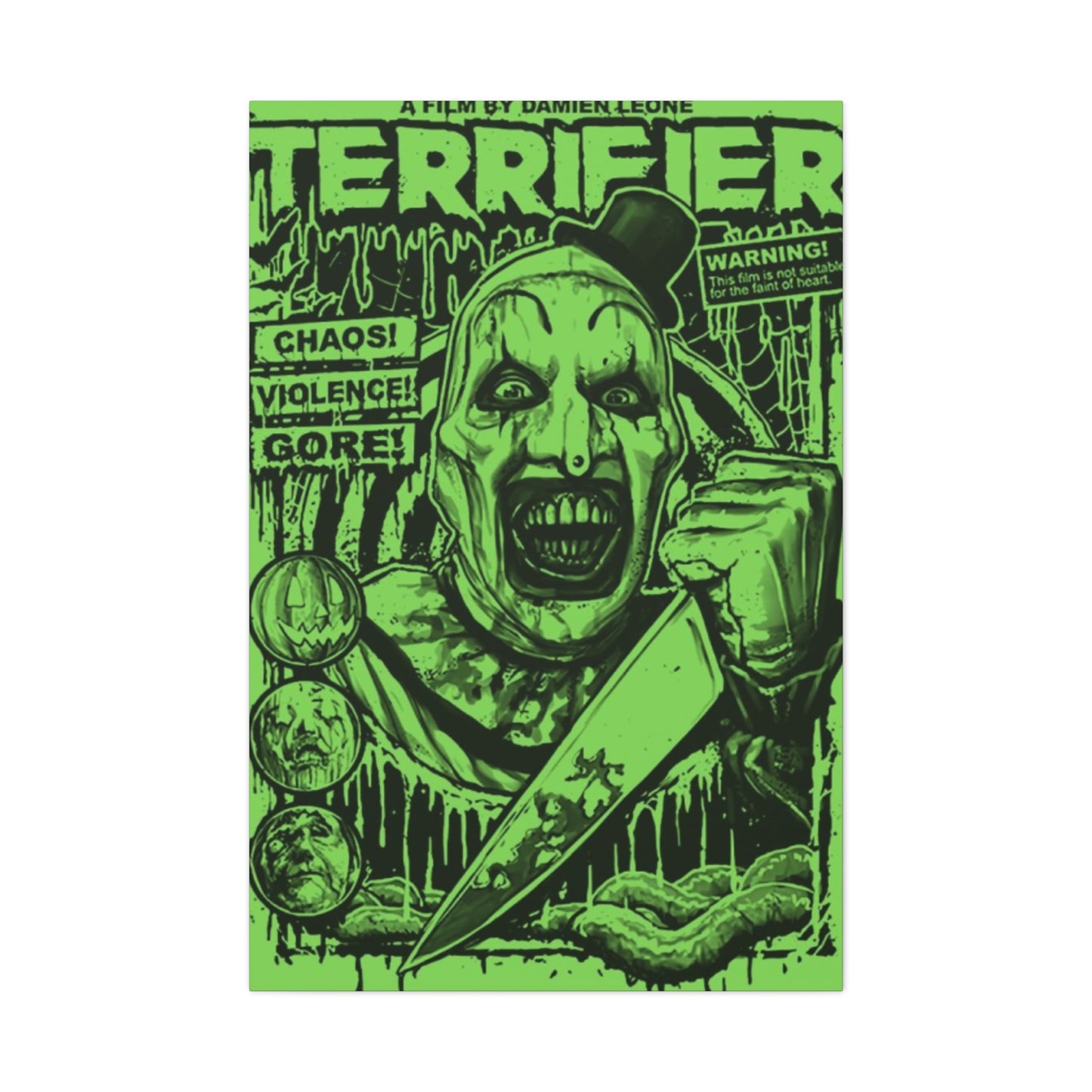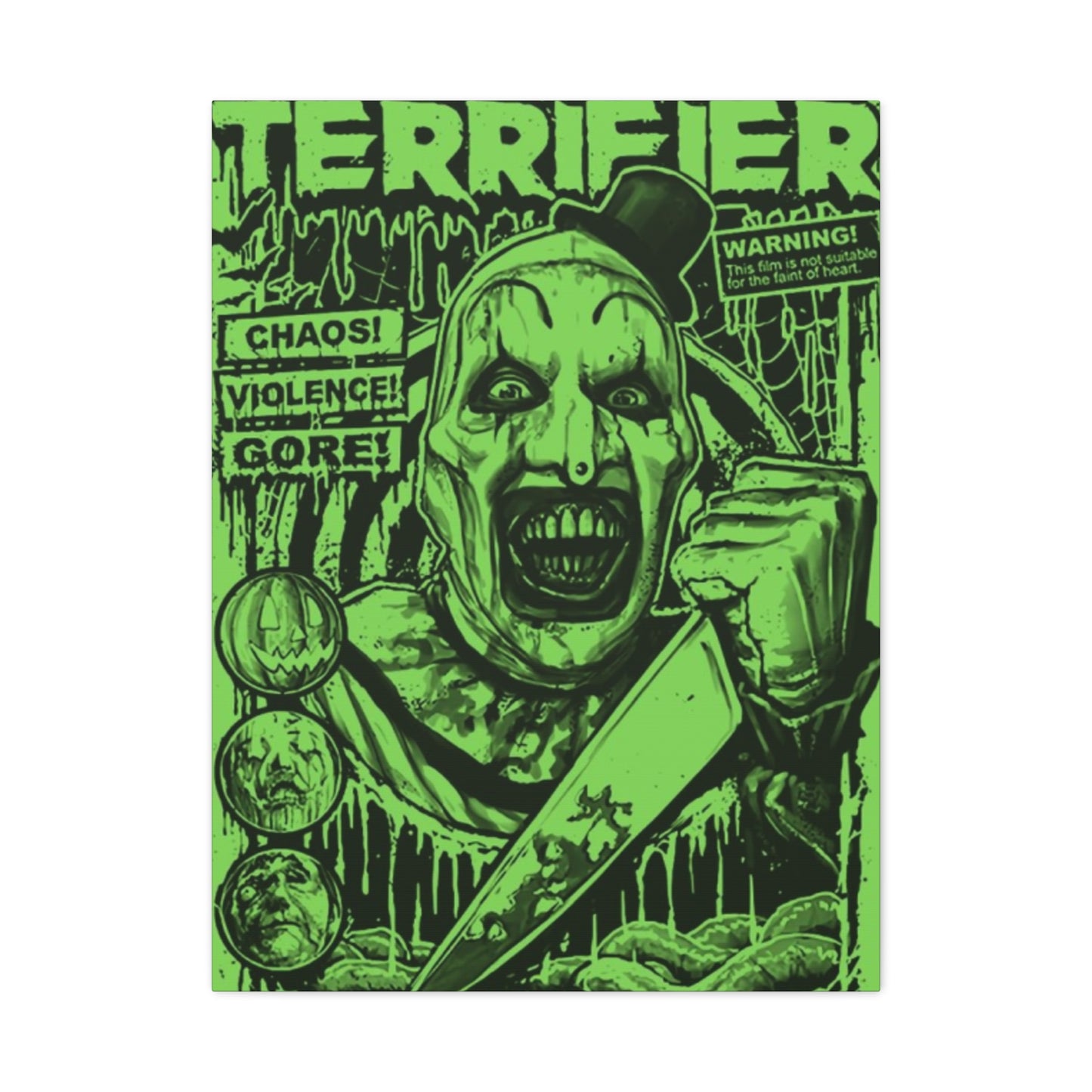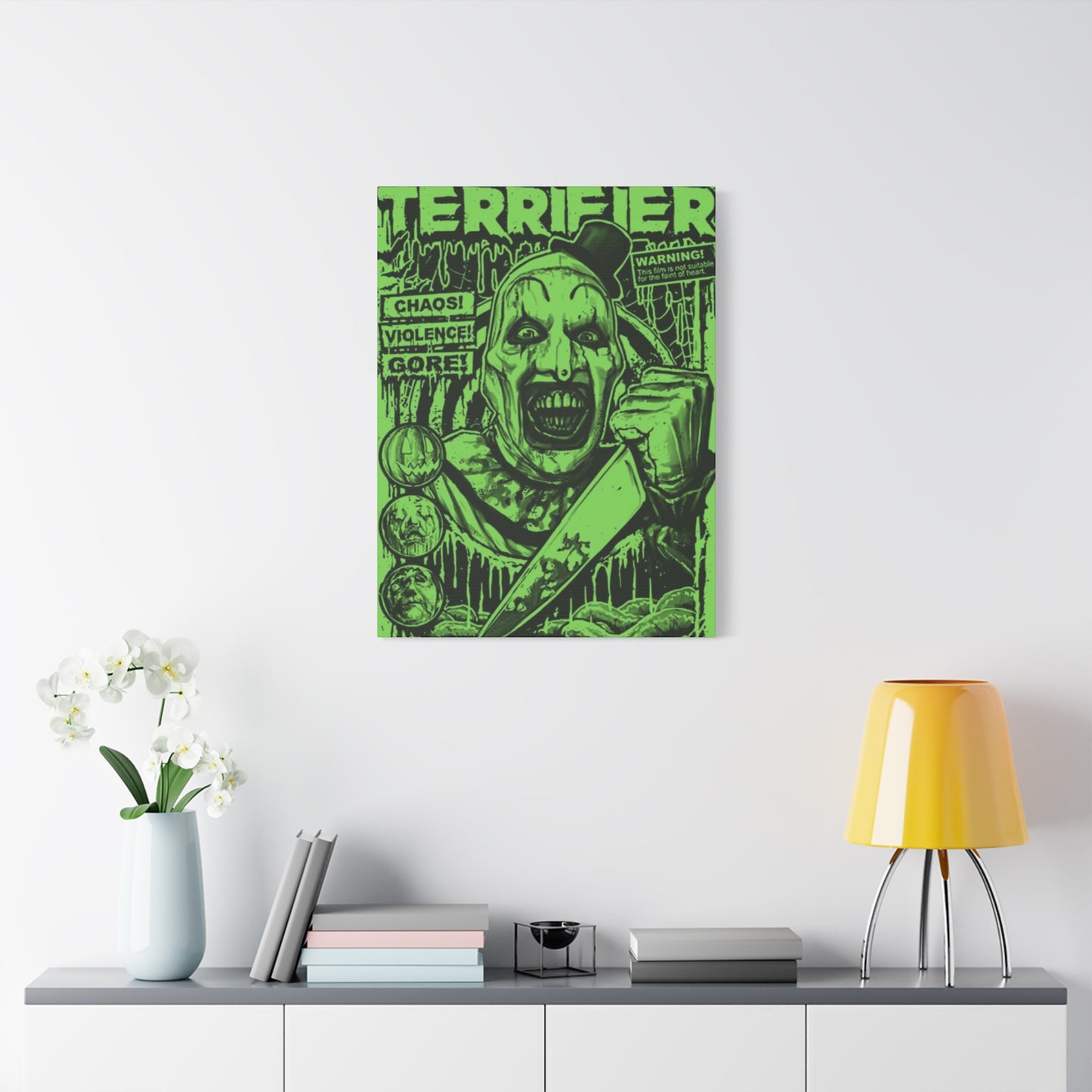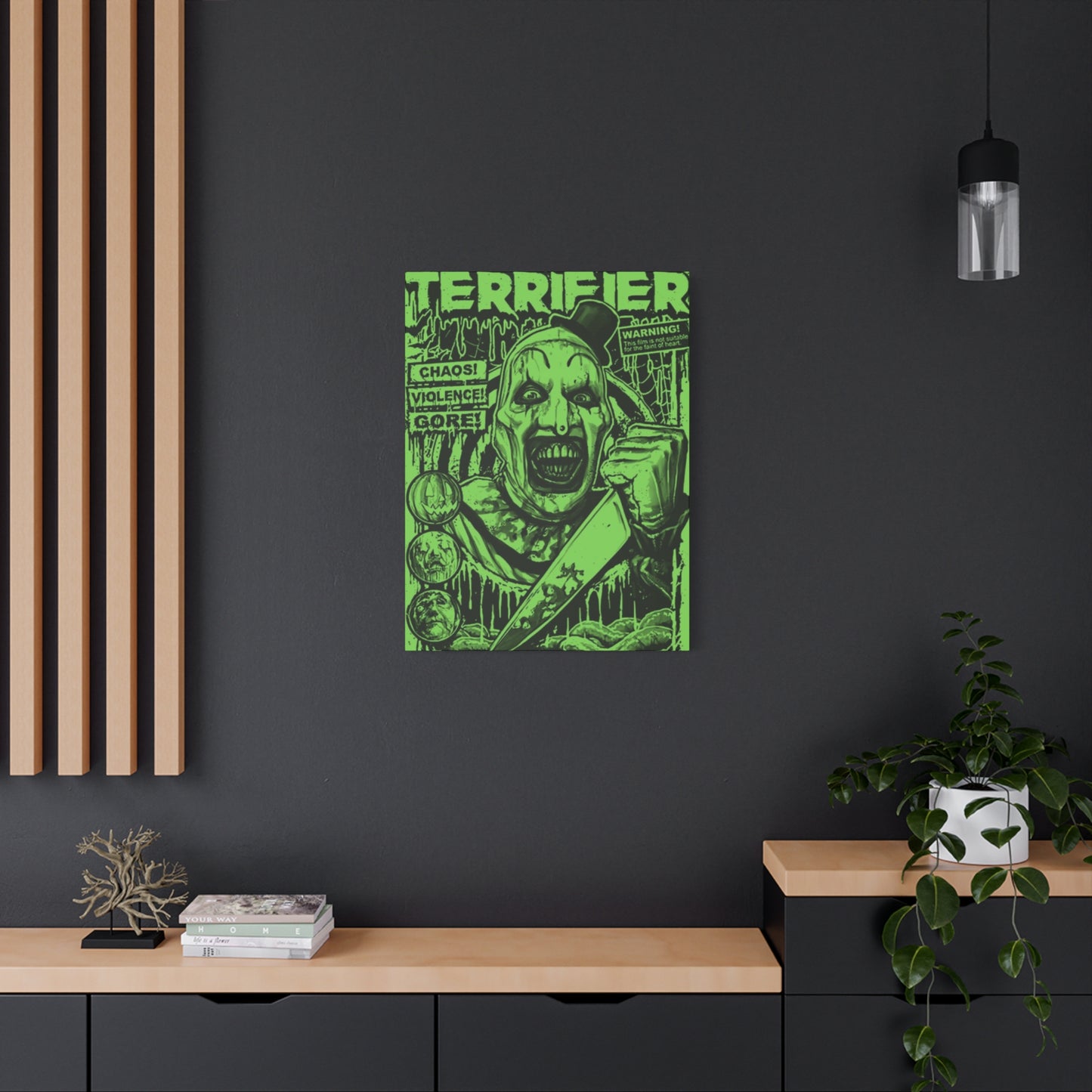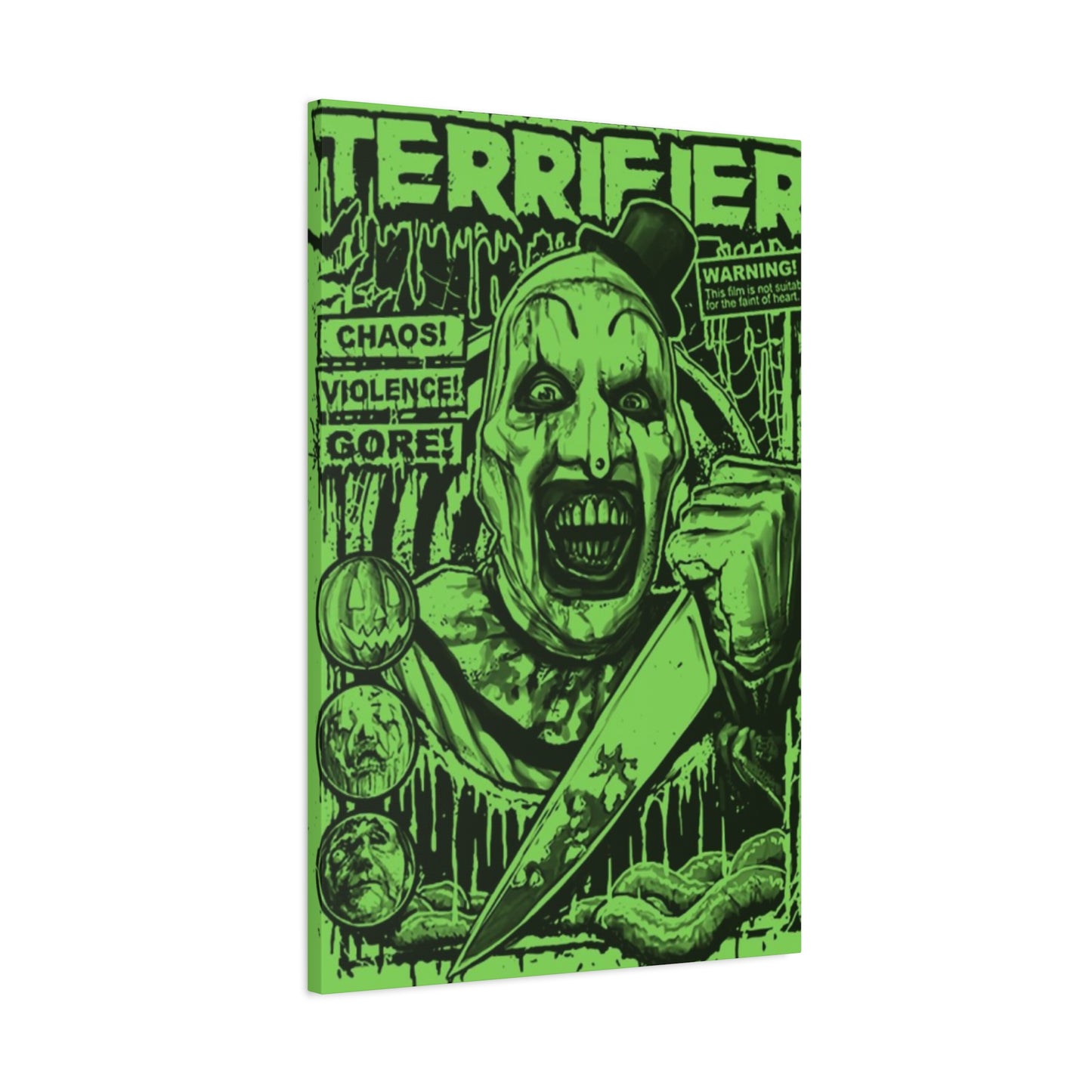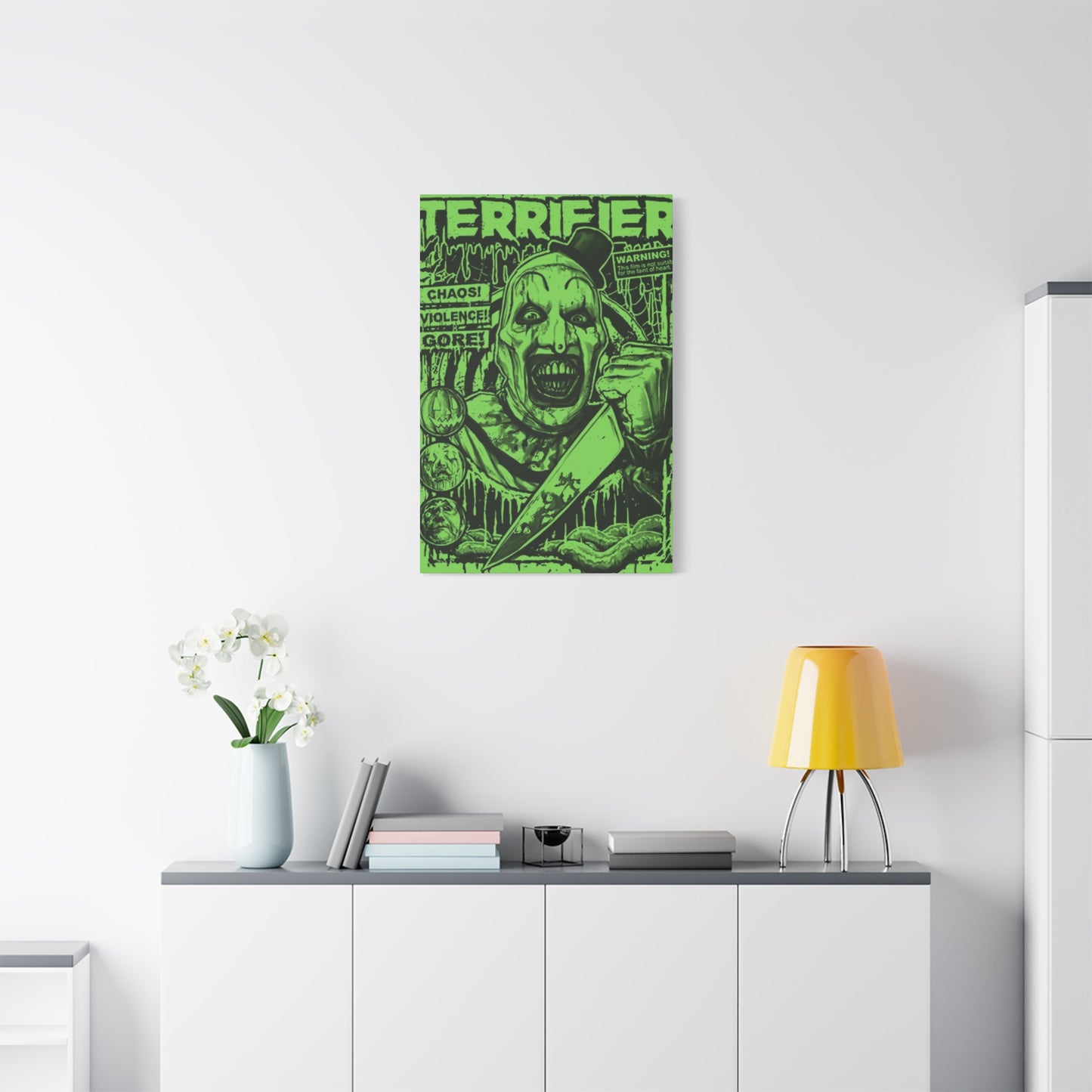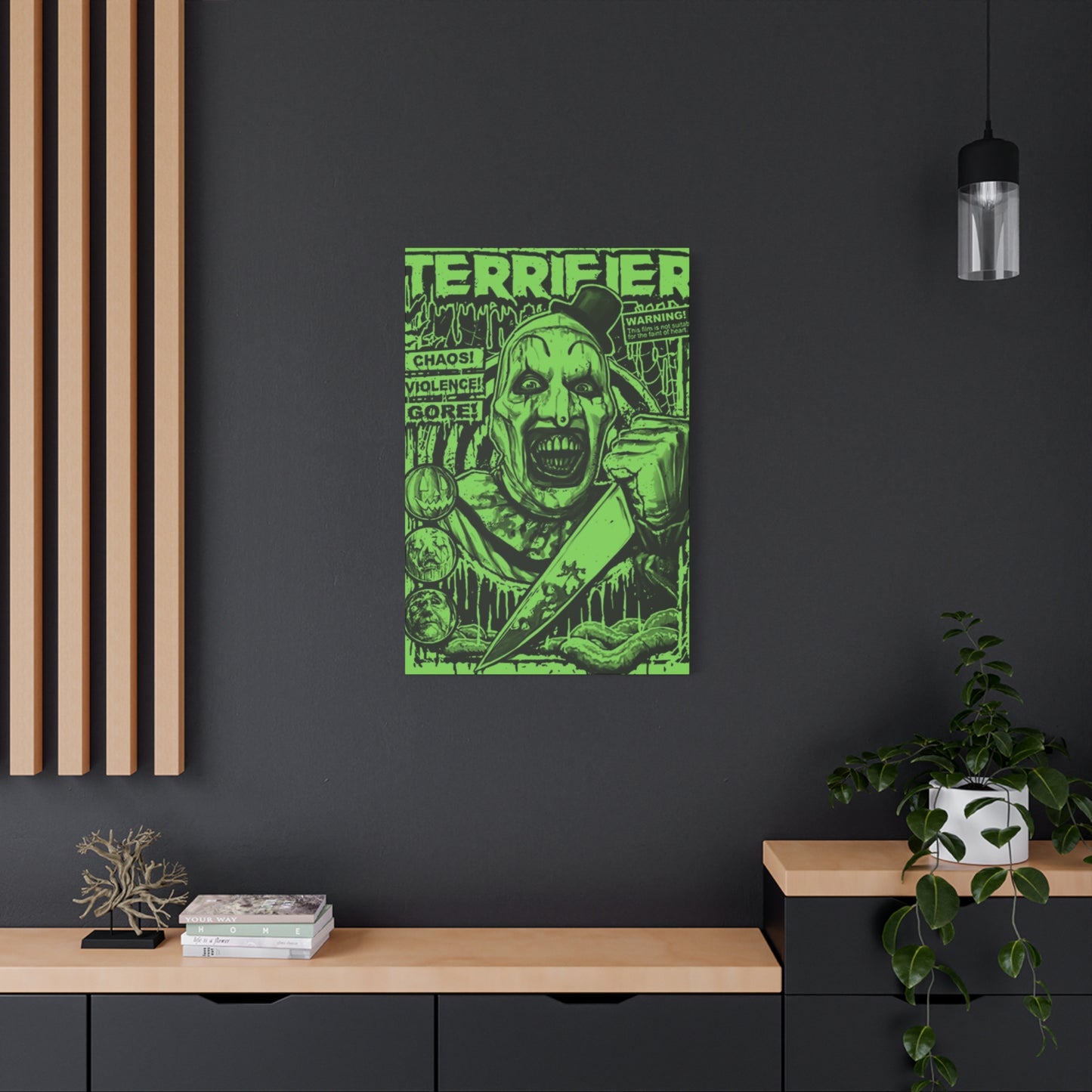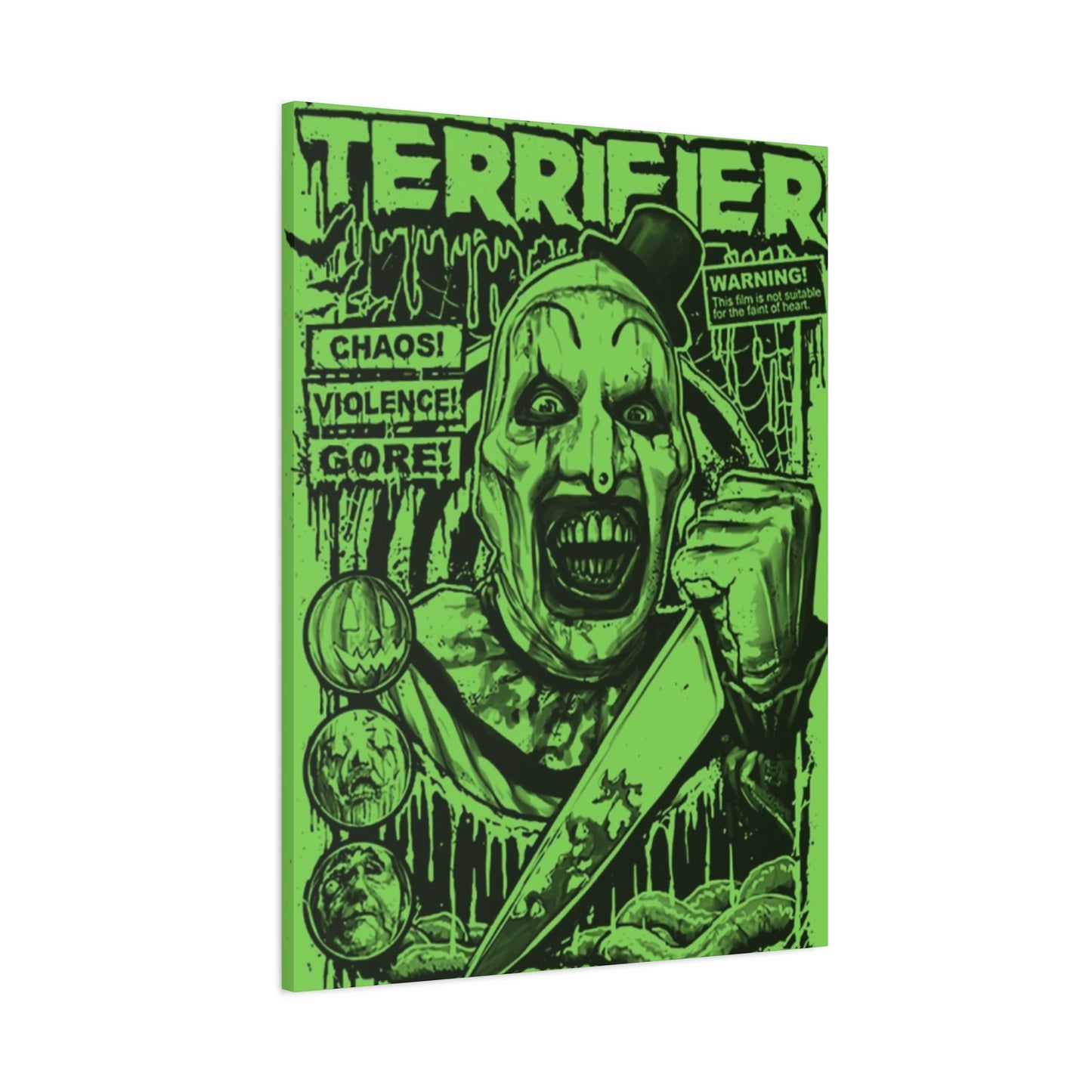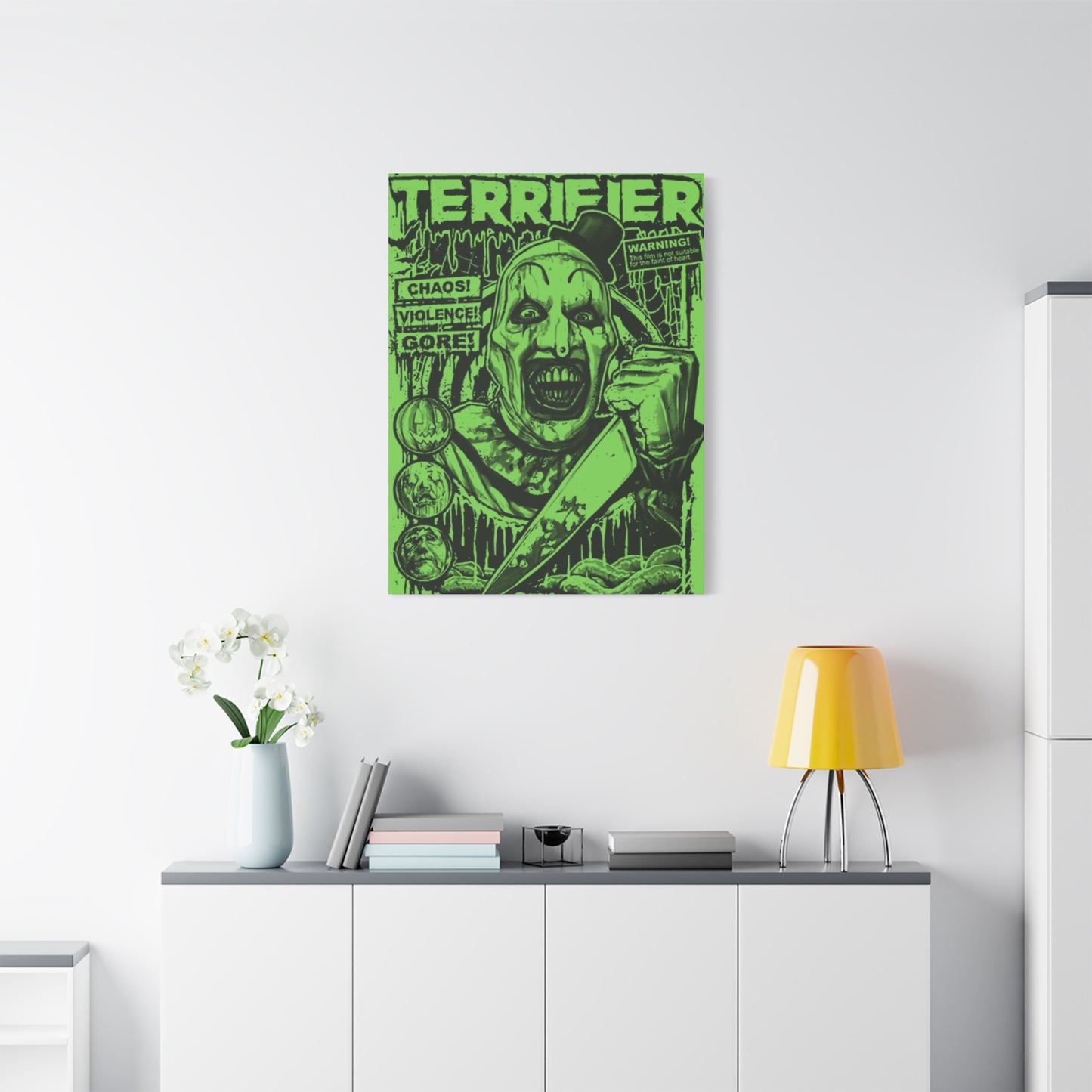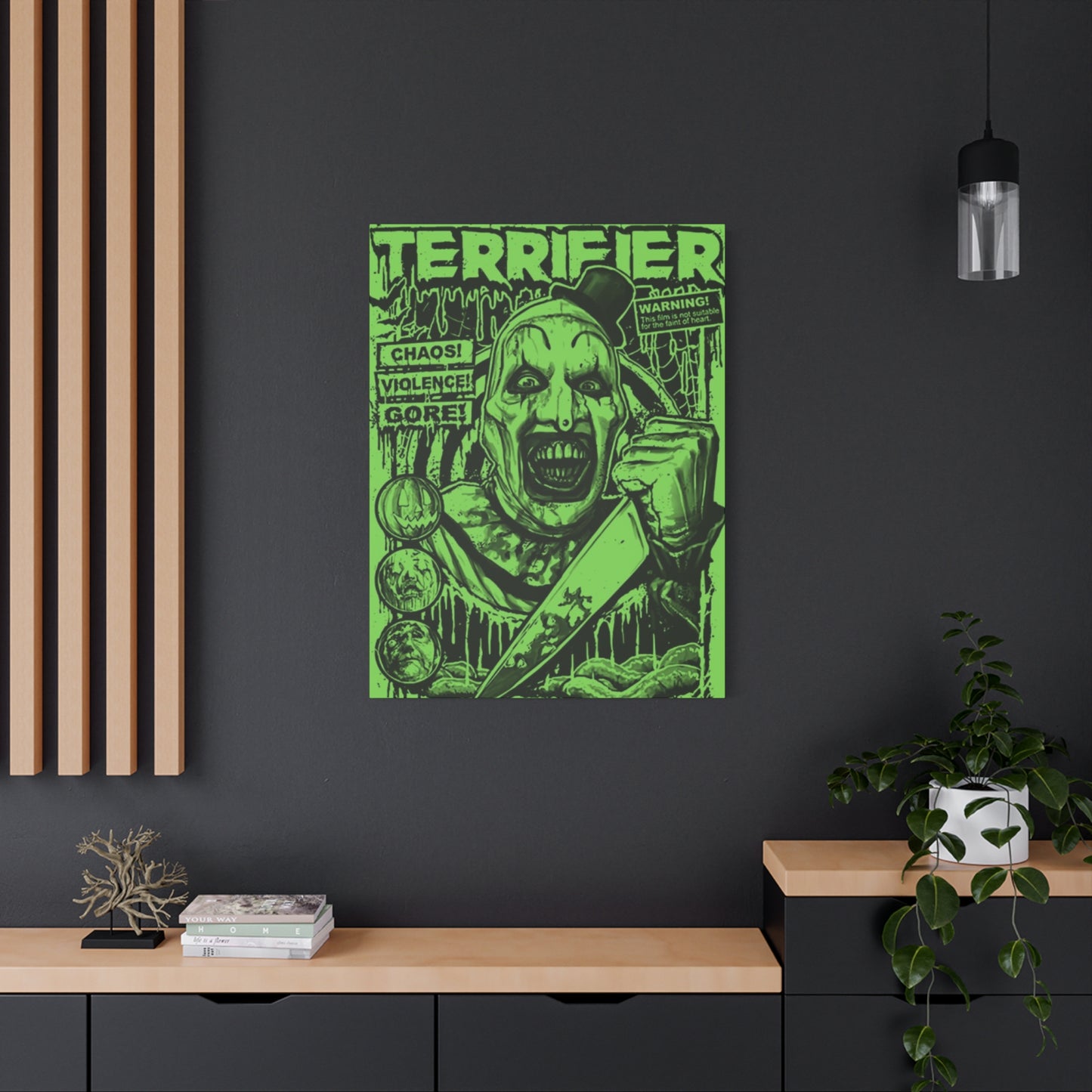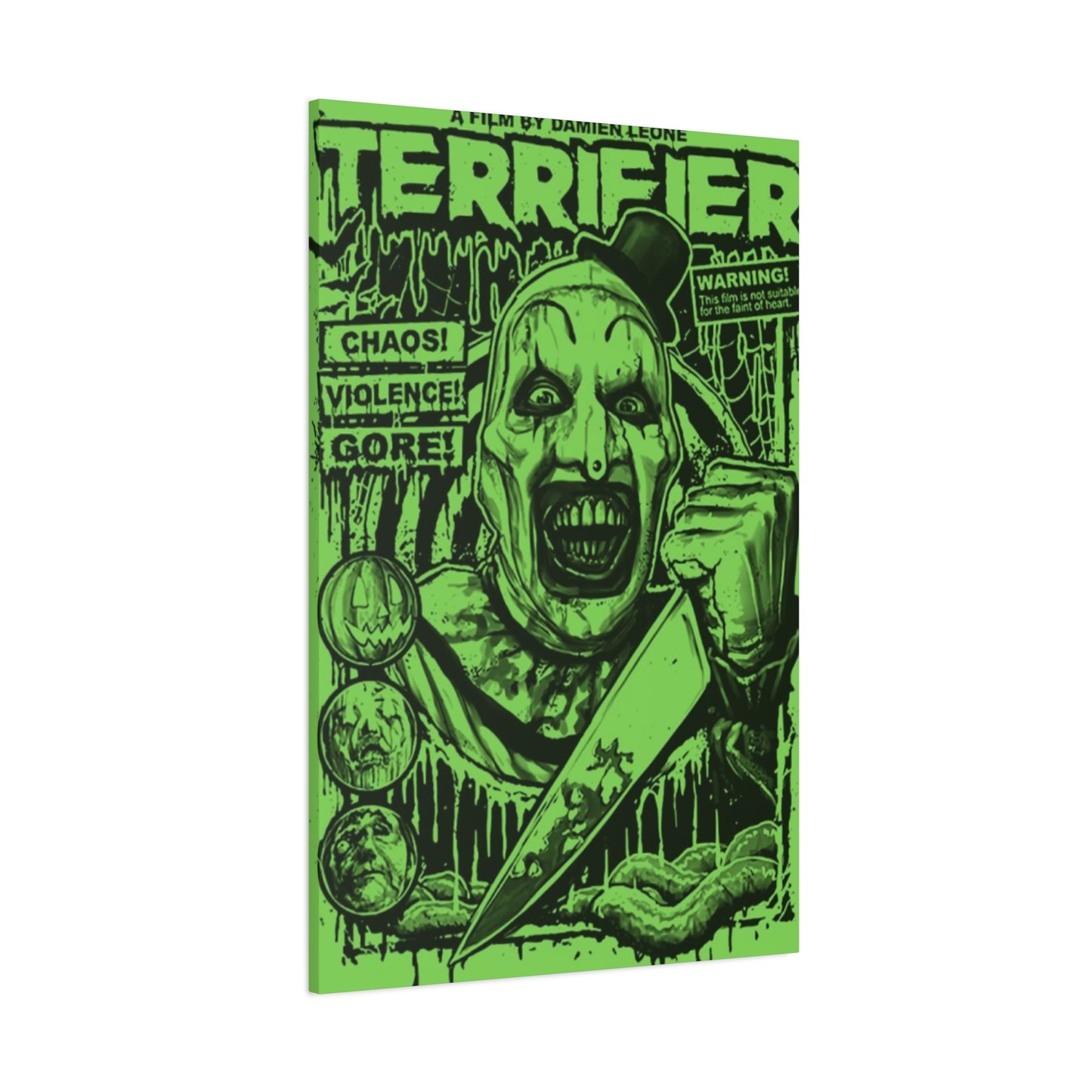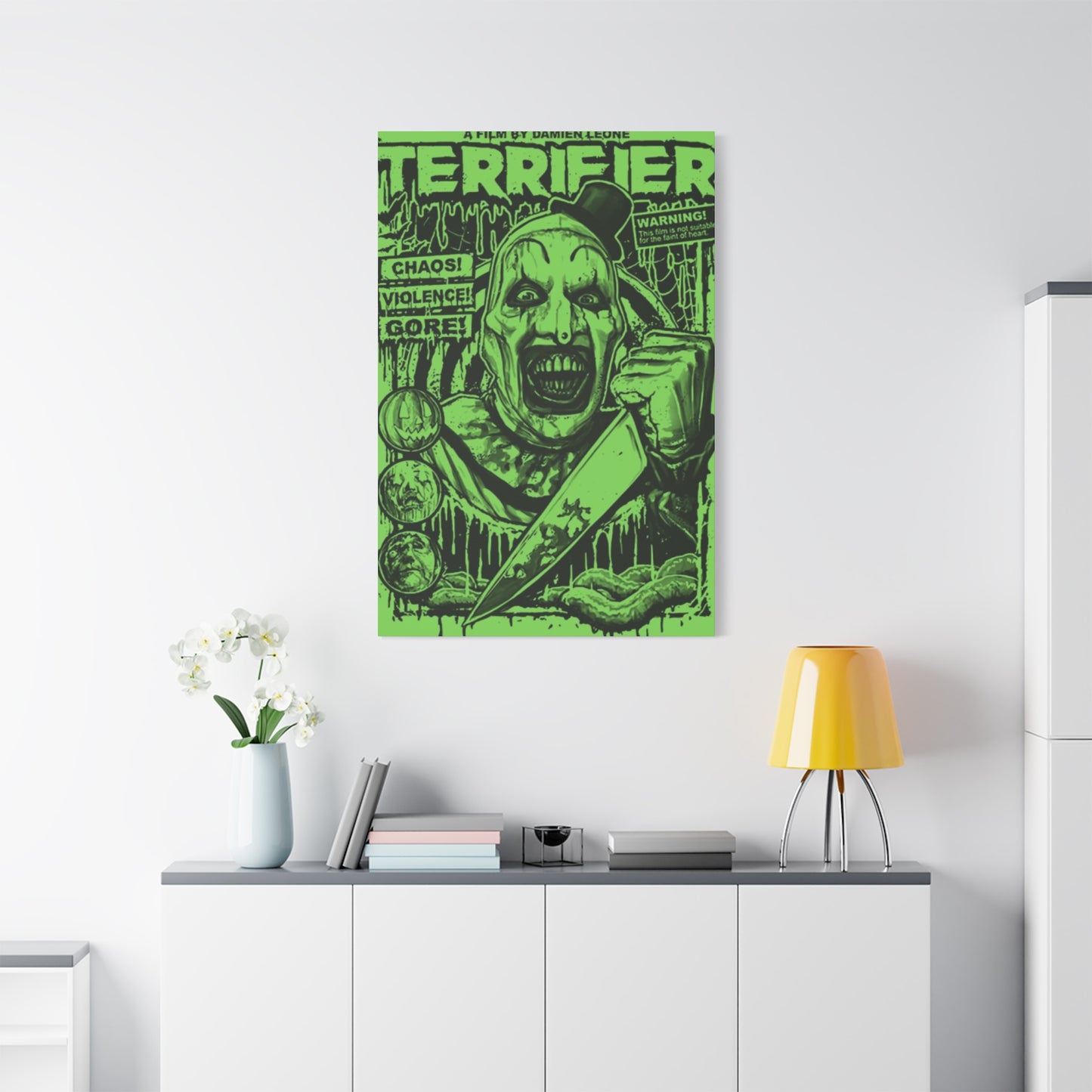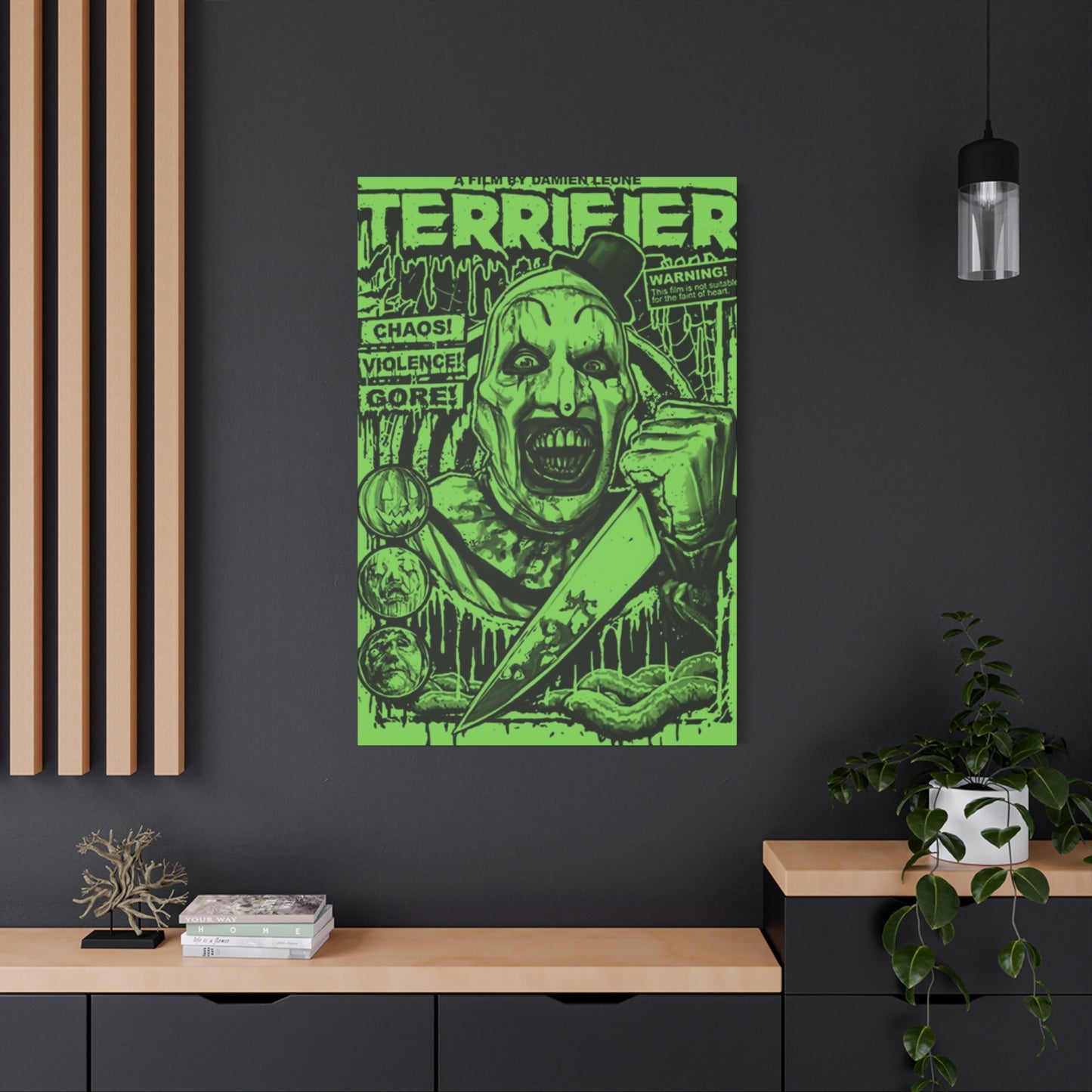Terrifier Horror Movie Poster Wall Art: A Comprehensive Analysis of Modern Horror Cinema Decoration
The world of horror cinema has experienced a remarkable renaissance in recent years, with independent films gaining unprecedented recognition and cult followings. Among these standout productions, the Terrifier franchise has emerged as a cultural phenomenon that has captivated audiences worldwide with its unapologetically brutal approach to horror storytelling. This surge in popularity has naturally extended beyond the screen, manifesting in various forms of merchandise and collectibles that allow fans to express their appreciation for this groundbreaking series. One of the most sought-after items in this merchandise ecosystem is the Terrifier horror movie poster wall art canvas prints, which have become essential pieces for horror enthusiasts looking to transform their living spaces into shrines dedicated to this terrifying masterpiece.
The phenomenon of decorating personal spaces with horror movie memorabilia represents more than just aesthetic choices. It reflects a deeper connection between viewers and the films that have left indelible marks on their psyche. When someone chooses to display a Terrifier canvas print in their home, they are making a statement about their taste in cinema, their appreciation for practical effects and old-school horror craftsmanship, and their willingness to embrace the darker aspects of entertainment. These canvas prints serve as conversation starters, pieces of art that simultaneously horrify and fascinate visitors, and constant reminders of the visceral experiences that quality horror cinema can provide.
The Cultural Impact of Terrifier Franchise on Horror Cinema
The Terrifier franchise has fundamentally altered the landscape of independent horror cinema since its inception. What began as a modest production with limited resources has evolved into a cultural touchstone that demonstrates the enduring appeal of character-driven horror narratives. The films center around Art the Clown, a silent, sadistic antagonist whose theatrical makeup and disturbing presence have made him one of the most recognizable horror icons of the modern era. Unlike many contemporary horror villains who rely heavily on computer-generated effects and supernatural elements, Art the Clown represents a return to tangible, practical horror that audiences can viscerally feel.
The success of these films has proven that there remains a substantial audience hungry for uncompromising horror experiences that push boundaries and challenge conventions. This audience has demonstrated remarkable loyalty and enthusiasm, creating a robust market for associated merchandise including canvas prints, posters, and various forms of wall art. The demand for Terrifier horror movie poster wall art canvas prints specifically reflects how deeply the franchise has resonated with horror fans who want to surround themselves with imagery from films that have genuinely affected them.
The franchise's approach to horror harks back to the slasher films of the 1980s while incorporating modern filmmaking techniques and sensibilities. This unique combination has created something that feels simultaneously nostalgic and fresh, appealing to longtime horror fans who grew up with classic slasher films as well as newer audiences discovering the genre. The visual style of the films, characterized by stark contrasts, bold colors, and disturbing imagery, translates exceptionally well to canvas prints and wall art, making these decorative items highly desirable for collectors and casual fans alike.
Understanding Canvas Print Technology for Horror Movie Art
Canvas prints have become the preferred medium for reproducing movie posters and promotional artwork because they offer several distinct advantages over traditional paper posters. The canvas printing process involves transferring high-resolution digital images onto specially treated canvas material using advanced printing technology that ensures color accuracy and longevity. This method produces artwork that closely resembles traditional oil paintings, giving movie posters an elevated, gallery-quality appearance that paper simply cannot match.
The texture of canvas adds depth and dimension to horror imagery, making the disturbing visuals from Terrifier even more impactful. When light hits a canvas print at different angles, the woven texture creates subtle variations in how the image appears, adding an almost three-dimensional quality to the artwork. This characteristic is particularly effective for horror movie art, where the interplay of light and shadow contributes significantly to the overall atmosphere and mood of the piece.
High-quality canvas prints designed for Terrifier horror movie poster wall art utilize pigment-based inks that resist fading and maintain their vibrancy for decades when properly cared for. These archival-quality inks ensure that the disturbing reds, deep blacks, and stark whites that characterize the franchise's visual identity remain true to the original artwork for years to come. The canvas material itself is typically made from polyester or cotton blends that have been specifically engineered for printing applications, providing an ideal surface that accepts ink beautifully while remaining durable enough to withstand the test of time.
The process of creating these canvas prints begins with sourcing the highest resolution versions of official movie posters and promotional artwork. Professional print shops use sophisticated color management systems to ensure that the printed canvas accurately reproduces the original colors and tones. The canvas is then carefully stretched over wooden frames, a process that requires skill and precision to ensure the image remains properly aligned and the canvas maintains appropriate tension. Many premium canvas prints feature gallery wrapping, where the image extends around the sides of the frame, creating a finished look that eliminates the need for additional framing.
Art the Clown as an Iconic Horror Character
Art the Clown has ascended to join the pantheon of legendary horror villains, standing alongside characters like Michael Myers, Jason Voorhees, Freddy Krueger, and Pinhead. What makes Art particularly disturbing is his complete silence and unpredictability. Unlike villains who explain their motivations or engage with their victims verbally, Art operates entirely through physical expression and body language, making him deeply unsettling on a primal level. His exaggerated mime-like movements combined with his penchant for extreme violence create a cognitive dissonance that makes him genuinely terrifying.
The character's visual design is deceptively simple yet incredibly effective. The stark black and white makeup creates maximum contrast, making Art's face memorable and instantly recognizable. His costume, which appears to be a deliberately shabby clown outfit, suggests a character who has completely abandoned any pretense of entertainment or joy, perverting the traditional clown archetype into something purely sinister. This design translates exceptionally well to canvas prints, where the high contrast and bold lines make for striking wall art that commands attention.
Art's popularity as a character has driven much of the demand for Terrifier horror movie poster wall art canvas prints. Fans connect with the character on multiple levels, appreciating both the performance that brings him to life and the practical effects work that makes his acts of violence so viscerally disturbing. Displaying Art the Clown in one's home through canvas prints represents an embrace of horror cinema's more extreme expressions, signaling to others that the owner appreciates horror that refuses to compromise or soften its impact for mainstream palatability.
The character's influence extends beyond the films themselves, inspiring countless fan artworks, cosplays, and interpretations. This active fan community has helped sustain interest in the franchise between film releases, creating a constant demand for officially licensed merchandise including canvas prints. The character's design offers artists and designers numerous opportunities for creative interpretation, resulting in a diverse array of poster designs and artwork that appeal to different aesthetic preferences within the horror community.
Decorating Philosophy for Horror Enthusiasts
Creating a living space that reflects one's passion for horror cinema requires thoughtful consideration of how different elements work together to establish the desired atmosphere. Terrifier horror movie poster wall art canvas prints serve as focal points that can anchor an entire room's aesthetic, but they must be integrated carefully to avoid overwhelming the space or creating an environment that feels more like a college dorm room than a curated living area.
The key to successfully incorporating horror movie art into home decor lies in treating these pieces with the same respect and consideration one would give to any fine art. Canvas prints should be properly lit to maximize their visual impact, with consideration given to how natural and artificial light sources interact with the artwork throughout the day. Strategic placement is crucial; a large Terrifier canvas might work perfectly above a media console in a home theater room, while smaller prints might be better suited for hallways, home offices, or dedicated entertainment spaces.
Color coordination plays an important role in making horror movie art feel intentional rather than haphazard. The Terrifier franchise features a distinctive color palette dominated by blacks, whites, and reds, with occasional pops of other colors. These colors can be echoed throughout the room in smaller decorative elements like throw pillows, lighting fixtures, or accent furniture to create visual harmony. This approach allows the canvas prints to stand out while still feeling connected to the overall design scheme.
Balance is another critical consideration. A room entirely covered in horror movie posters can feel chaotic and overwhelming, diminishing the impact of individual pieces. Instead, treat each canvas print as a carefully selected artwork that deserves its own space to breathe. Surrounding horror movie art with more neutral decor elements allows the eye to rest and makes the impactful imagery even more striking when it does appear. This restraint actually amplifies the effectiveness of the horror artwork by creating contrast and preventing visual fatigue.
Various Poster Designs Available for Terrifier Franchise
The Terrifier franchise has generated an impressive array of official and unofficial poster designs, each capturing different aspects of the films' aesthetic and appeal. Original theatrical posters typically focus on Art the Clown as the central figure, using bold compositions that immediately communicate the film's horror credentials. These designs often employ dramatic lighting, stark color contrasts, and positioning that makes Art appear both theatrical and threatening, perfectly encapsulating his character.
Alternative poster designs have become increasingly popular within the horror community, with talented artists creating their own interpretations of the franchise. These alternative designs might emphasize different aspects of the films, focusing on specific scenes, supporting characters, or thematic elements. Some adopt minimalist approaches, using simple shapes and limited color palettes to suggest the horror rather than depicting it explicitly. Others embrace maximalist aesthetics, creating densely detailed compositions that reward close examination.
Limited edition poster releases have become highly collectible, often featuring unique artwork created specifically for special screenings, anniversary celebrations, or home video releases. These limited runs frequently sell out quickly and can appreciate significantly in value over time, making them attractive to collectors who view their horror movie art as investments as well as decorative pieces. Canvas print versions of these limited designs offer accessibility to fans who missed the original releases or prefer the durability and presentation quality that canvas provides over paper.
Promotional posters from different countries and regions offer fascinating variations in how the franchise has been marketed to different audiences. International poster designs sometimes emphasize different elements of the films, reflecting cultural variations in horror preferences and marketing strategies. Collecting canvas prints of these international posters allows fans to appreciate the global reach of the franchise while acquiring unique pieces that stand apart from more commonly seen domestic designs.
Quality Considerations When Purchasing Horror Movie Canvas Prints
Not all canvas prints are created equal, and understanding quality markers helps ensure satisfaction with horror movie wall art purchases. The resolution of the source image fundamentally determines the quality of the final print. Low-resolution images may appear acceptable on screens but reveal pixelation, blurriness, and loss of detail when printed at poster sizes. High-quality Terrifier horror movie poster wall art canvas prints should utilize source files with sufficient resolution to maintain clarity and sharpness even when printed at large dimensions.
The type of canvas material significantly impacts both appearance and longevity. Premium canvas prints use heavyweight canvas, typically measured in ounces per square yard, with heavier canvas generally indicating higher quality. The weave of the canvas affects how the image appears; tighter weaves provide smoother surfaces that better capture fine details, while looser weaves create more visible texture. For horror movie art with lots of fine details, tighter weaves typically produce superior results.
Ink quality separates professional-grade canvas prints from budget alternatives. Pigment-based inks offer superior longevity compared to dye-based inks, resisting fading from light exposure and environmental factors for decades rather than years. The color gamut of the inks determines how accurately the canvas can reproduce the original artwork's colors. Wide-gamut inks can reproduce more intense colors and subtle gradations, particularly important for horror movie art that relies on impactful reds and deep blacks to create visceral reactions.
Frame quality deserves consideration even though it often goes unnoticed. The wooden stretcher bars over which canvas is stretched should be substantial enough to prevent warping and maintain proper tension. Cheap frames may warp over time, causing the canvas to sag or distort. Gallery-wrapped canvas, where the image extends around the frame edges, requires precise stretching to ensure the image aligns correctly on all sides. Corner construction should be solid, with properly secured joints that will withstand years of display.
Proper Lighting Techniques for Horror Movie Wall Art
Lighting dramatically affects how canvas prints appear and can mean the difference between artwork that fades into the background and pieces that command attention. Properly lighting Terrifier horror movie poster wall art canvas prints enhances their visual impact while protecting the artwork from light damage that could cause premature fading. The type, placement, and intensity of lighting all contribute to the overall presentation.
Picture lights mounted directly to frames or walls above artwork provide focused illumination that highlights the art while creating dramatic shadows and depth. These dedicated lighting fixtures come in various styles from traditional brass fixtures to modern LED strips, allowing selection based on the overall room aesthetic. Picture lights work particularly well for horror movie art, as they can create dramatic contrast that enhances the ominous atmosphere the artwork conveys. Adjustable picture lights offer flexibility to direct light precisely where desired, emphasizing particular elements of the composition.
Track lighting and recessed spotlights offer flexible solutions for lighting multiple pieces or creating adjustable displays. These systems allow individual light fixtures to be positioned and aimed at specific artworks, with the flexibility to adjust as collections change or pieces are rearranged. Dimmer switches provide additional control, allowing light intensity to be adjusted based on time of day, natural light conditions, or desired mood. For horror movie art, the ability to dim lights can create more atmospheric presentations that enhance the sinister nature of the imagery.
Ambient lighting from general room fixtures affects how canvas prints appear in the context of the entire space. While dedicated art lighting provides focused illumination, ambient lighting prevents the artwork from appearing too disconnected from its surroundings. Balancing ambient and focused lighting creates depth and prevents harsh contrasts that can be visually uncomfortable. For rooms dedicated to entertainment and horror movie appreciation, colored LED lighting can be used creatively to create immersive environments that complement the artwork while establishing specific moods.
Natural light presents both opportunities and challenges for displaying canvas prints. While natural light can beautifully illuminate artwork during daytime hours, ultraviolet radiation from sunlight causes fading and deterioration over time. Canvas prints should never be placed in direct sunlight, which accelerates fading dramatically. If displaying artwork near windows is unavoidable, UV-filtering window films or glass can reduce harmful radiation while allowing visible light to pass through. Alternatively, positioning canvas prints on walls perpendicular to windows rather than directly opposite them minimizes direct sun exposure while still benefiting from natural light.
Caring for and Maintaining Canvas Print Collections
Proper care and maintenance ensure Terrifier horror movie poster wall art canvas prints remain vibrant and undamaged for decades. Canvas prints require surprisingly little maintenance but benefit from regular attention to environmental factors and occasional cleaning. Understanding proper care techniques protects investments and preserves artwork for future enjoyment.
Dust accumulation represents the most common issue affecting canvas prints. Dust settles on the textured canvas surface, gradually dulling colors and obscuring details. Regular dusting using soft, clean microfiber cloths or soft-bristled brushes prevents buildup. Dusting should be gentle to avoid pushing dust particles into the canvas weave, using light sweeping motions across the surface. For particularly delicate or valuable prints, specialized art-cleaning brushes designed for canvas provide the safest cleaning option.
Environmental conditions significantly impact canvas print longevity. Excessive humidity can cause canvas to sag or develop mold, while extremely dry conditions may cause canvas to become brittle or crack. Maintaining relative humidity between 40-60% provides optimal conditions for canvas preservation. Temperature fluctuations should be minimized, as expansion and contraction from temperature changes can stress both canvas and frame materials. Keeping canvas prints away from heating vents, air conditioning outlets, and drafty windows helps maintain stable conditions.
Smoke and cooking residue can gradually deposit on canvas prints, particularly in homes where smoking occurs indoors or in kitchens and dining areas. These residues create films that dull artwork and can be difficult to remove without professional intervention. Displaying canvas prints away from areas where smoking occurs and in rooms separate from kitchen spaces prevents most contamination. When contamination does occur, professional art restoration services can often clean canvas prints without causing damage.
Handling canvas prints requires care to avoid accidental damage. The canvas surface can be punctured or torn by sharp objects, and oils from fingers can leave permanent marks. When moving or adjusting canvas prints, handling should be limited to frame edges rather than the canvas surface itself. For long-term storage, canvas prints should be protected with acid-free paper or cloth and stored flat or carefully upright in climate-controlled environments. Never roll stretched canvas prints, as this can cause permanent damage to both canvas and paint layers.
Framing Options Beyond Standard Canvas Stretching
While stretched canvas prints offer classic presentation, additional framing options allow further customization of Terrifier horror movie poster wall art canvas prints to match specific aesthetic preferences or provide additional protection. Floating frames create the illusion that canvas prints hover within their frames, with a gap between the canvas edge and frame providing visual interest and dimension. These frames work particularly well for gallery-wrapped canvas where the image extends around the sides, as the floating presentation allows this dimensional aspect to remain visible.
Traditional frames with glass or acrylic glazing provide maximum protection for canvas prints, shielding them from dust, humidity, and physical damage while adding formal presentation. However, glazing introduces reflections that can interfere with viewing the artwork, and the glass or acrylic adds weight and cost. Anti-reflective glazing minimizes reflection issues but commands premium prices. For valuable or particularly important pieces, the added protection may justify these drawbacks.
Shadow box framing creates depth by mounting canvas prints several inches away from backing boards, creating three-dimensional displays that add drama and presence. Shadow boxes work exceptionally well for horror movie art, as the depth and shadows created by this presentation method enhance the ominous nature of the imagery. These frames can also accommodate additional memorabilia, creating mixed-media displays that tell broader stories about the franchise or personal experiences with the films.
Rustic and distressed frames complement the gritty aesthetic of horror cinema, particularly for franchises like Terrifier that embrace practical effects and raw presentation. Weathered wood frames, metal frames with patina, or deliberately distressed finishes create visual connections between the artwork and its presentation, suggesting age and history. These frame styles work particularly well in industrial or eclectic spaces where polished, traditional framing might feel out of place.
Authenticity and Licensing Considerations
The market for horror movie merchandise includes both officially licensed products and unauthorized reproductions, making it important for collectors to understand the differences and make informed purchasing decisions. Officially licensed Terrifier horror movie poster wall art canvas prints support the filmmakers and rights holders who created the franchise, ensuring that those responsible for the art receive appropriate compensation for its use. Licensed products typically feature authentication markers, holographic stickers, or certificates of authenticity that verify their legitimate status.
Unlicensed reproductions present ethical and quality concerns. While often available at lower prices, these products deprive creators of rightful compensation and may feature inferior printing quality, poor color accuracy, or unauthorized modifications to original artwork. Additionally, purchasing unlicensed merchandise may support operations that ignore intellectual property rights across multiple properties, contributing to broader problems within creative industries.
Quality differences between licensed and unlicensed products often become apparent upon close inspection. Licensed merchandise typically uses high-resolution source files provided by rights holders, ensuring optimal image quality. Unlicensed products may be created from screenshots, low-resolution promotional images, or scans of existing merchandise, resulting in noticeably inferior print quality with visible pixelation, color banding, or loss of detail.
For collectors concerned about value retention, licensed merchandise generally maintains and appreciates in value more reliably than unlicensed alternatives. Limited edition licensed prints, particularly those from official releases or special events, can become significantly valuable over time as availability decreases. Unlicensed products lack this collectibility and may actually decrease in value as superior official options become available.
DIY Canvas Print Creation for Horror Fans
Technically inclined fans may consider creating their own Terrifier horror movie poster wall art canvas prints using print-on-demand services or local print shops. This approach offers maximum customization and can be cost-effective, but requires understanding several technical considerations to achieve satisfactory results. Creating DIY canvas prints begins with sourcing high-quality digital files of the desired artwork, which presents immediate challenges regarding image resolution and copyright considerations.
Image resolution requirements for large format printing exceed what typical web images provide. Professional canvas printing requires source files with minimum resolutions of 150 pixels per inch at final print size, with 300 pixels per inch representing optimal quality. A 24x36 inch print at 300 PPI requires a source file containing 7200x10800 pixels, substantially larger than images typically found online. Attempting to enlarge smaller images to meet these requirements results in pixelation and blurriness that no amount of editing can fully correct.
Color management ensures that printed canvas matches expectations based on screen previews. Computer monitors display colors using RGB color space while printers use CMYK color space, and not all RGB colors can be accurately reproduced in CMYK. Professional print services use color management systems and provide printed proofs showing how final prints will appear, but DIY approaches may lack these safeguards, resulting in disappointing color accuracy. Converting images to CMYK color space before submitting for printing and requesting printed proofs helps minimize surprises.
Print service selection significantly impacts final quality. Local print shops offer the advantage of face-to-face consultation and the ability to inspect materials and samples before committing to orders. However, capabilities and quality vary widely between shops. Online print-on-demand services provide convenient ordering and competitive pricing but lack the personal interaction that helps ensure satisfactory results. Reviewing samples, reading customer reviews, and potentially ordering small test prints before committing to expensive large formats helps ensure service quality meets expectations.
Copyright considerations cannot be ignored when creating DIY canvas prints. Using copyrighted artwork without permission violates intellectual property rights, regardless of whether prints are for personal use or commercial sale. While enforcement varies, respecting copyright protects creators and avoids potential legal consequences. Fans wishing to create truly unique pieces might consider commissioning original artwork from independent artists who can create pieces inspired by franchises without directly reproducing copyrighted material.
Integration with Home Theater and Entertainment Spaces
Terrifier horror movie poster wall art canvas prints find natural homes in dedicated entertainment spaces where horror movie appreciation takes center stage. Home theater rooms, media rooms, and entertainment lounges benefit from themed decoration that enhances the viewing experience and celebrates the films being watched. Properly integrating horror movie art into these spaces creates immersive environments that amplify the impact of the entertainment.
Strategic placement of canvas prints within home theaters affects both aesthetics and functionality. Prints should not be positioned where they might cause distracting reflections on screens during viewing, typically meaning walls adjacent to or behind seating rather than walls behind projection screens or televisions. Side walls provide excellent locations for canvas prints, where they remain visible when entering the room or during pre-show socializing but don't interfere with the viewing experience once films begin.
Lighting design in entertainment spaces must balance showcasing wall art with creating optimal viewing conditions for screens. Picture lights on horror movie canvas prints can be wired to separate switches or automated systems that turn them off when movies begin, eliminating potential light contamination. Alternatively, dimmable LED lighting allows adjustment to levels that maintain subtle illumination of artwork without overwhelming screen images. Smart lighting systems can be programmed to create lighting scenes that automatically adjust all room lighting based on activity, from full illumination for socializing to complete darkness for movie watching.
Acoustic considerations in home theaters may affect canvas print placement and selection. Canvas stretched over wooden frames provides minimal acoustic treatment, but large expanses of bare canvas can contribute to sound reflections. For serious home theater installations where acoustic optimization is priority, acoustic panels can be printed with canvas artwork, combining decoration with sound treatment. These specialized panels absorb sound while displaying desired imagery, providing dual functionality that maximizes the utility of wall space.
Themed design schemes tie horror movie art into broader room aesthetics. A home theater dedicated to horror could feature multiple horror franchise canvas prints arranged chronologically to tell the story of horror cinema evolution, or grouped by subgenre to explore different approaches to frightening audiences. Complementary decor elements like vintage horror movie props, posters, or memorabilia create comprehensive themed environments that fully immerse occupants in horror culture.
Psychological Impact of Horror Imagery in Living Spaces
Surrounding oneself with horror imagery through decorative items like Terrifier horror movie poster wall art canvas prints creates interesting psychological dynamics that deserve consideration. Horror imagery triggers specific emotional and physiological responses that affect mood and psychological state, and chronic exposure through environmental decoration may amplify these effects. Understanding these impacts helps individuals make informed decisions about incorporating horror art into living spaces.
Desensitization represents one potential outcome of regular exposure to horror imagery. Repeated viewing of disturbing images can reduce the emotional intensity of responses, potentially diminishing the impact of horror entertainment over time. However, this desensitization typically remains context-specific; desensitization to horror movie imagery doesn't necessarily extend to real-world violence or disturbing content. For some horror fans, this desensitization is actually desirable, allowing them to appreciate the artistic and technical aspects of horror more objectively without becoming overwhelmed by visceral reactions.
Conversely, regular exposure to personally meaningful horror imagery can maintain emotional connections to formative media experiences. Horror fans often report that certain films or franchises played significant roles in their lives, perhaps seen during formative years or associated with important relationships or events. Displaying art from these franchises serves as daily reminder of those connections, maintaining emotional bonds to past experiences and reinforcing aspects of personal identity related to horror fandom.
Visitors' reactions to horror-decorated spaces vary widely based on individual horror tolerance and cultural backgrounds. While horror fans typically respond positively to seeing their interests reflected in home decor, individuals less comfortable with horror imagery may find spaces decorated with intense horror art unsettling or unwelcoming. This dynamic deserves consideration for spaces where diverse guests will visit, potentially informing decisions about which rooms receive horror decoration and how intensely themed those spaces become.
The cathartic value of horror engagement extends to environmental exposure. Horror allows safe exploration of fear, anxiety, and mortality within controlled contexts. Living with horror imagery maintains ongoing connection to these themes, potentially providing psychological benefits through regular, low-intensity engagement with difficult emotions and concepts. This ongoing relationship with horror themes through environmental exposure differs from the intense, time-limited exposure of watching horror films, creating sustained rather than punctuated horror engagement.
Building Collections and Curating Personal Horror Museums
Serious collectors of horror movie memorabilia often progress from acquiring individual pieces to building comprehensive collections that function as personal museums documenting horror cinema history. Terrifier horror movie poster wall art canvas prints might represent starting points or centerpieces within larger collections that expand across multiple franchises, eras, and media formats. Developing systematic approaches to collection building ensures cohesion and purpose rather than random accumulation.
Thematic focus provides direction for collection development. Collectors might focus on specific subgenres like slasher films, particular eras such as 1980s horror, specific franchises, or work by particular directors, artists, or production companies. This focus creates collections with clear narratives and allows deep exploration of particular aspects of horror cinema. A collection focused on independent horror might feature Terrifier prominently alongside other indie horror successes, telling the story of horror cinema existing outside major studio systems.
Condition standards guide acquisition decisions and preservation efforts. Collectors must decide whether prioritizing pristine, mint condition items or accepting pieces with wear and aging that provide historical character. Canvas prints offer advantages for collectors preferring pristine presentation, as the durable canvas material and modern printing techniques ensure new pieces arrive in perfect condition, unlike vintage paper posters that may show age-related deterioration. Establishing clear condition standards prevents collections from becoming cluttered with lower-quality pieces that dilute overall impact.
Documentation adds significant value to collections beyond the physical items themselves. Maintaining detailed records of each piece's provenance, including purchase date, source, price, edition information, and any authentication documentation preserves important historical information and proves valuable for insurance purposes or potential future sales. Photographing items and maintaining digital archives ensures records persist even if physical documentation is lost or damaged. For particularly valuable or rare pieces, professional appraisals document authenticity and value.
Display rotation keeps collections fresh and allows showcasing more items than available wall space permits. Rather than leaving the same pieces displayed indefinitely, rotating artwork seasonally, thematically, or based on personal interest maintains visual interest and prevents pieces from becoming invisible through over-familiarity. Climate-controlled storage for items not currently displayed protects them from environmental damage while awaiting their turns in the display rotation.
Profile of Horror Movie Art Collectors
Understanding the psychological motivations behind collecting horror movie memorabilia provides insight into why individuals choose to surround themselves with Terrifier horror movie poster wall art canvas prints and similar items. Horror collecting represents more than simple fandom; it reflects deeper psychological needs, identity expression, and relationship with fear and mortality. These motivations vary between individuals but share common themes that unite collectors across diverse backgrounds.
Identity expression through collection building allows individuals to externalize internal aspects of their personalities that might not be immediately apparent in other contexts. Horror fandom often exists somewhat outside mainstream cultural appreciation, making it a marker of alternative or countercultural identity. Displaying horror movie art announces one's willingness to embrace darker aesthetic sensibilities and challenging entertainment, potentially signaling nonconformity or rejection of sanitized mainstream media. For many collectors, their horror collections represent authentic self-expression in ways their professional lives or other social contexts may not permit.
Nostalgia drives significant collecting behavior, with individuals seeking to recapture feelings and experiences associated with formative encounters with horror media. Horror films often create powerful memories due to their intense emotional impact, and the fear, excitement, and exhilaration experienced during initial viewings become powerful nostalgic touchstones. Acquiring memorabilia from these formative films allows collectors to maintain tangible connections to those experiences, serving as physical anchors to personally significant memories.
Completionism appeals to collectors who find satisfaction in systematically acquiring comprehensive sets of related items. The drive to obtain every poster from a particular franchise, all limited editions from a specific artist, or complete representations of a particular era provides clear goals and ongoing motivation. This systematic approach to collecting creates ongoing engagement and provides regular dopamine rewards as collection gaps fill. The clearly defined nature of completionist goals provides structure that many collectors find deeply satisfying.
Aesthetic appreciation motivates collectors who respond strongly to the visual artistry of horror movie poster design. These individuals may view horror film art as legitimate artistic expression deserving serious consideration and preservation. The bold colors, striking compositions, and emotionally evocative imagery characteristic of horror poster design appeal to these collectors on purely aesthetic levels, regardless of their relationship with the source films. For these collectors, horror movie posters represent accessible contemporary art that resonates with their personal aesthetic preferences.
Relationship Between Terrifier Franchise and Practical Effects Community
The Terrifier franchise's commitment to practical effects has endeared it to communities that value traditional craftsmanship in horror filmmaking. This relationship between the films and practical effects appreciation influences demand for associated merchandise including Terrifier horror movie poster wall art canvas prints. Understanding this connection provides context for the franchise's particular appeal within horror communities and why its visual imagery translates so effectively to decorative art.
Practical effects represent physical, tangible creations executed through makeup, prosthetics, miniatures, and mechanical devices rather than digital effects. This approach connects directly to horror cinema's roots and the techniques that created iconic moments in classic horror films. The visceral, physical nature of practical effects creates different viewing experiences than computer-generated imagery, with audiences responding to the tangible reality of what appears on screen. The Terrifier franchise's extensive use of practical gore effects creates disturbing realism that digital effects often struggle to match.
The craftsmanship involved in creating practical effects appeals to audiences who appreciate technical artistry and specialized skills. Viewing practical effects showcases work by talented artists, mechanics, and technicians whose contributions directly visible on screen. This transparency contrasts with digital effects, where the technology and artist contributions remain largely invisible to audiences. Horror fans who value practical effects often develop deep appreciation for the artists creating these works, viewing them as legitimate craftspeople deserving recognition and respect.
Behind-the-scenes content showing practical effects creation has developed substantial audiences, with special features, making-of documentaries, and social media content focusing on effects work often generating as much interest as the films themselves. This fascination with craft extends to associated merchandise, where awareness of the artistry involved in creating the imagery enhances appreciation for posters and other promotional materials. Canvas prints featuring Art the Clown showcase both the character and the makeup artistry that brings him to life, appealing to audiences on multiple levels.
The practical effects community maintains strong presence in horror fandom, with conventions, publications, and online communities dedicated to discussing and celebrating practical effects work. The Terrifier franchise's prominence within these communities raises its profile and drives merchandise demand. Collectors who value practical effects particularly seek out memorabilia from films that demonstrate commitment to this craft, viewing their collections as celebrations of traditional filmmaking techniques in an increasingly digital landscape.
Cross-Pollination Between Horror and Fine Art Communities
The boundaries between horror movie poster art and fine art have become increasingly permeable, with contemporary art communities demonstrating growing appreciation for horror aesthetics and horror fans recognizing the artistic merit of the genre's visual culture. This cross-pollination benefits collectors of Terrifier horror movie poster wall art canvas prints and similar items by elevating horror movie art's cultural status and expanding contexts in which it can be seriously discussed and appreciated.
Contemporary artists increasingly reference horror cinema in their work, creating pieces that explicitly engage with horror iconography, themes, and aesthetics. Gallery exhibitions dedicated to horror movie art bring these pieces into fine art contexts where they receive serious critical consideration typically reserved for established art movements. These exhibitions validate horror movie poster art as legitimate artistic expression worthy of preservation, study, and collection, challenging hierarchies that historically dismissed commercial art associated with popular entertainment.
Art movements including lowbrow art and pop surrealism have explicitly embraced horror aesthetics, with artists creating works that synthesize horror movie imagery with fine art techniques and sensibilities. These movements reject the traditional distinction between high and low culture, arguing that commercial art forms including movie posters, comic books, and album covers deserve equal consideration with traditional fine art. Horror collectors benefit from this movement as it creates broader cultural acceptance of their collections and provides theoretical frameworks for discussing horror art's significance.
Academic study of horror cinema and associated visual culture has expanded significantly, with film studies programs, art history departments, and cultural studies programs producing scholarship analyzing horror's artistic and cultural dimensions. This academic attention lends intellectual credibility to horror collecting and appreciation, providing analytical tools and historical context that deepen understanding and appreciation. Academic conferences dedicated to horror studies bring together scholars, filmmakers, artists, and fans, creating productive dialogues across different horror community segments.
Museum acquisitions of horror movie posters and memorabilia signal mainstream cultural acceptance and preservation commitment. Major museums have mounted exhibitions featuring classic horror movie posters while incorporating these items into permanent collections. These institutional endorsements validate horror movie art's historical and cultural significance while ensuring preservation for future generations. Collectors can take pride knowing their personal collections preserve and celebrate art forms that major cultural institutions now recognize as valuable.
The rising auction prices for vintage horror movie posters demonstrate growing recognition of their value as both cultural artifacts and investment-grade art. Rare posters from classic horror films have sold for tens of thousands of dollars at major auction houses, prices that rival many contemporary fine artworks. These valuations reflect both scarcity and cultural significance, positioning horror movie poster art as serious collecting category that major collectors and institutions increasingly pursue.
Regional Variations in Horror Appreciation and Collecting
Horror appreciation varies significantly across different geographic regions, cultural contexts, and national traditions, influencing both the types of horror content that resonate with audiences and the merchandise markets that develop around them. Understanding these regional variations provides context for the Terrifier franchise's international appeal and the global market for associated merchandise including Terrifier horror movie poster wall art canvas prints.
North American horror traditions emphasize slasher films, supernatural horror, and monster movies, with strong cultural attachment to franchises from the 1970s and 1980s that defined contemporary horror conventions. The Terrifier franchise's conscious evocation of this era positions it perfectly for North American audiences with deep nostalgia for classic slasher cinema. Collecting culture in North America reflects this appreciation, with strong markets for vintage horror movie posters, memorabilia from classic franchises, and contemporary properties that successfully channel retro aesthetics.
European horror traditions vary significantly by country, with Italian giallo films, Spanish horror cinema, French extreme horror, and British gothic horror each representing distinct aesthetic and thematic approaches. European audiences often demonstrate greater acceptance of extreme content and artistic experimentation in horror, potentially making them particularly receptive to the Terrifier franchise's uncompromising approach. European collecting markets reflect these diverse traditions, with collectors seeking both international franchises and regional horror properties specific to their national cinema traditions.
Asian horror cinema has developed distinctive aesthetic approaches emphasizing psychological horror, supernatural entities, and social commentary that differ markedly from Western horror conventions. Japanese, Korean, Thai, and other Asian horror traditions have influenced global horror cinema while maintaining distinct regional characteristics. The international success of Asian horror has created robust collecting markets within the region while introducing Western collectors to Asian horror aesthetics, expanding and diversifying global horror collecting communities.
Latin American horror cinema combines indigenous folklore, Catholic imagery, and social realism to create unique horror expressions that differ from both North American and European traditions. Mexican horror cinema in particular has developed rich traditions incorporating luchador wrestlers, vampires, and monsters in ways specific to Mexican cultural contexts. These regional traditions support collecting communities that value both local horror properties and international franchises that resonate with regional audiences.
Censorship and content restrictions in various countries affect both horror film distribution and merchandise availability. Some regions prohibit or heavily restrict horror content, limiting both theatrical releases and consumer products including posters and merchandise. These restrictions create interesting market dynamics where horror collectibles may become particularly valuable due to scarcity while underground markets develop to serve audiences in restrictive environments. International online retail has partially mitigated these restrictions by enabling cross-border commerce, though import restrictions and customs enforcement vary.
Conclusion:
The phenomenon of Terrifier horror movie poster wall art canvas prints represents far more than simple merchandising of popular entertainment. These decorative pieces embody complex intersections of art, commerce, fandom, identity, and cultural expression that reflect broader dynamics in how contemporary audiences engage with media properties they find meaningful. The canvas prints serve simultaneously as art objects, cultural artifacts, identity markers, and nostalgic touchstones, fulfilling multiple functions that explain their enduring appeal and cultural significance.
The technical sophistication of modern canvas printing technology has elevated horror movie poster reproduction to levels that genuinely qualify as fine art rather than mere commercial merchandise. The archival quality inks, museum-grade canvas materials, and professional stretching techniques create pieces with visual impact and longevity rivaling traditional art forms. This technical excellence enables horror movie imagery to command the same respect and serious consideration historically reserved for more conventional artistic subjects, challenging cultural hierarchies that dismissed commercial art associated with popular entertainment.
The cultural moment currently elevating horror cinema from dismissible genre fare to recognized artistic and cultural expression creates particularly favorable conditions for horror movie art collecting. Academic study, critical appreciation, museum exhibitions, and mainstream media coverage validate what dedicated fans have long understood: horror cinema represents legitimate artistic expression addressing fundamental human concerns about mortality, fear, violence, and the boundaries of acceptable representation. Collecting horror movie art participates in this broader cultural reclamation project, insisting that the visual culture surrounding horror cinema deserves preservation, study, and appreciation.
The Terrifier franchise specifically exemplifies independent horror cinema's capacity to achieve cultural impact without major studio backing or compromising artistic vision for commercial palatability. The franchise's success demonstrates continuing appetite for uncompromising horror that respects audience intelligence and willingness to confront disturbing material. Supporting this franchise through merchandise purchases including canvas prints rewards filmmakers who take creative risks and proves to industry observers that markets exist for horror that refuses to soften its edges. This economic support enables continued production of challenging horror content that pushes boundaries and explores dark territories mainstream cinema avoids.
Personal expression through interior decoration allows individuals to externalize internal aspects of identity, values, and interests that might not manifest in other life aspects. Choosing to display horror movie art announces appreciation for darker aesthetic sensibilities and willingness to engage with challenging entertainment forms. For horror fans, these displays represent authentic self-expression and connection with communities sharing similar interests. The canvas prints create daily reminders of personally significant media experiences while signaling to visitors aspects of the owner's personality, interests, and values.

















